The designation of local historic districts has always been controversial in Saratoga Springs. Julie Stokes, founding Executive Director of the Saratoga Springs Preservation Foundation, recalled Monday night. “It was contentious and the final meeting literally took place in a boxing ring in the Musical Hall of City Hall with the City Council sitting on the stage while an attorney and I argued for designation at the center of the boxing ring surrounded by a large crowd that the City Council chambers and the City Courtroom could not accommodate.” In 1978, the Foundation won the match.
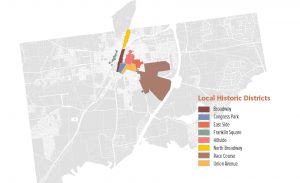
Map displaying the eight historic districts of Saratoga Springs.
That victory in the ring resulted in eight local historic districts being designated, requiring that all exterior changes, demolition, and new construction of more than 700 properties be approved by the Design Review Commission. Those efforts along with others made Saratoga Springs a leader in historic preservation across the state.
In that same room, 32 years later, I attempted to make the same argument to expand the local North Broadway district in an effort to prevent the demolition of 23 Greenfield Avenue. Unfortunately, I was unsuccessful. Property owners of the proposed district expansion did not want any additional review. They viewed the designation as onerous, potentially limiting what they could do to their property, and decreasing their property values. This was despite a number of studies of other cities demonstrating that the opposite is true – that values of properties with additional oversight are enhanced. An economic analysis had never been done for Saratoga Springs.
This year the Saratoga Springs Preservation Foundation, in partnership with the City of Saratoga Springs, undertook an economic analysis of historic preservation and the results were shared with the public Monday at the Saratoga Springs Public Library and the following evening at the City Council meeting.
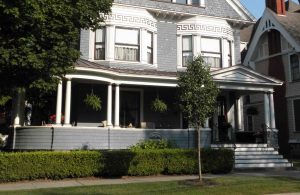
A Victorian home located in the East Side Historic District.
The eight historic districts collectively account for 6% of land area, 9% of properties within the city and 11% of the population. Nationally recognized economic analyst and author, Donovan Rypkema of PlaceEconomics, reported that properties located in historic districts are more valuable and are increasing in value more rapidly than comparable properties in the rest of the city and contribute 14% of the total assessed value of the city.
The average value of houses in local historic districts is 75% more than those not in a local district. The average square foot value is $265 for houses in a local historic district versus $230 for houses not located in a historic district, a difference of 15%. However, one may think that this is only true for the grand homes on North Broadway or Union Avenue, not a typical house. The study determined that a “typical” house for Saratoga Springs is a three bedroom, two bath house with approximately 1,900 square feet of above grade finished space.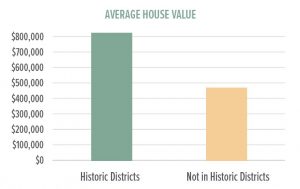 The average value of a “typical” house located in a historic district is $540,000 / $326 per square foot compared to elsewhere in the city where the average value is $448,000 / $266 per square foot. The increased values in historic districts held true regardless of the age, style, or condition of the house.
The average value of a “typical” house located in a historic district is $540,000 / $326 per square foot compared to elsewhere in the city where the average value is $448,000 / $266 per square foot. The increased values in historic districts held true regardless of the age, style, or condition of the house.
Understanding that Saratoga Springs has an expensive housing market, it is important to note that the study found that historic districts have a greater diversity of housing options than the rest of the city – single family, two-family, three-family, multi-family, and apartments – enabling residents of a wide range of economic levels, household sizes, and ages to live in our community. Historic districts help to preserve existing rental units. According to the 2016 US Census Bureau American Community Survey, the median rent in Saratoga Springs is $1,069 with 51% of the units in historic districts renting for less than $1,000, accounting for 22% of all units in the city under $1,000. It should also be noted that while the overall population of Saratoga Springs is 90% white, the local historic districts have greater diversity among African American, Asian, and other minority populations.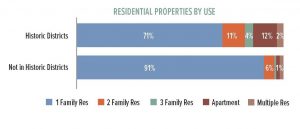
The study also highlighted the walkability score of the city, 45, making most errands car dependent, whereas the local historic districts have a score of 83, meaning most errands can be accomplished on foot. Transportation costs are typically the second largest expenditure following housing costs. People who live in walkable, mixed-use areas with access to jobs and services not only have lower transportation costs, they are more likely to know their neighbors and engage in the community – resulting in an improved quality of life.
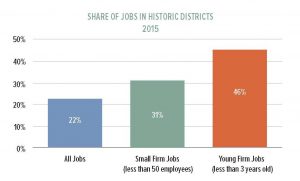 The study looked at employment within the local historic districts and found that they house 22% of all jobs in the city. More importantly 31% of all small firm jobs (less than 50 employees) and 46% of young firms (less than three years old) are located in historic districts. Also, historic districts are the location of a disproportionate share of jobs in the sectors where visitors spend their money – accommodations, bars/restaurants, and retail.
The study looked at employment within the local historic districts and found that they house 22% of all jobs in the city. More importantly 31% of all small firm jobs (less than 50 employees) and 46% of young firms (less than three years old) are located in historic districts. Also, historic districts are the location of a disproportionate share of jobs in the sectors where visitors spend their money – accommodations, bars/restaurants, and retail.
In addition to all of the analysis that was done, several state and federal historic rehabilitation tax credit commercial projects were highlighted – the Adelphi Hotel, the Algonquin, and the Woodlawn Row Houses – which resulted in nearly $50 million dollars of investment in our community. Those projects would not have been possible without the tax credits. Many properties in Saratoga Springs are eligible for the New York State Historic Homeowner Tax Credit, allowing homeowners to receive a 20% tax credit, up to $50,000, for rehabilitation costs. This program provides important assistance to homeowners to preserve their homes. However, it is currently underutilized.
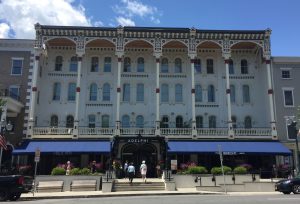
The newly reopened Adelphi Hotel generated tax revenue, job income and economic activity for the Saratoga Springs community.
The conclusion of the study is that people are willing to pay a “preservation premium” for homes located in the local historic districts. Interestingly, the number one variable in choice of a neighborhood is not affordability, convenience to work, or even quality of local schools, it is the “quality of neighborhood” according to a recent survey by the National Association of Realtors. Saratoga Springs’ local historic districts protect and enhance the quality of our neighborhoods. “The outcome of the study clearly shows that the decades of commitment by the City of Saratoga Springs and the community pays off economically and otherwise,” said Rypkema. He went on to say, “while only 6% of the land area of the city is in an historic district, it has set the pattern, quality, and attractiveness of Saratoga Springs. It is a stellar national example of long-term commitment to historic preservation.”
The study and final report, “Saratoga Springs: Enhancing the Values Through Historic Preservation,” were funded by a Certified Local Government Grant of the New York State Office of Parks, Recreation and Historic Preservation with additional funding provided by The Community/Land Preservation and Planning Fund of The Community Foundation for the Greater Capital Region. To learn more about the results of the study please visit https://www.saratogapreservation.org/wp-content/uploads/2019/02/2018-11-27_EIS_FINAL_Compressed.pdf.
Founded in 1977, the Saratoga Springs Preservation Foundation is a private, not-for-profit organization that promotes preservation and enhancement of the architectural, cultural and landscaped heritage of Saratoga Springs.
